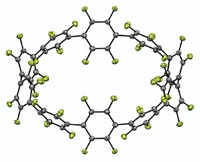Advertisement
Grab your lab coat. Let's get started
Welcome!
Welcome!
Create an account below to get 6 C&EN articles per month, receive newsletters and more - all free.
It seems this is your first time logging in online. Please enter the following information to continue.
As an ACS member you automatically get access to this site. All we need is few more details to create your reading experience.
Not you? Sign in with a different account.
Not you? Sign in with a different account.
ERROR 1
ERROR 1
ERROR 2
ERROR 2
ERROR 2
ERROR 2
ERROR 2
Password and Confirm password must match.
If you have an ACS member number, please enter it here so we can link this account to your membership. (optional)
ERROR 2
ACS values your privacy. By submitting your information, you are gaining access to C&EN and subscribing to our weekly newsletter. We use the information you provide to make your reading experience better, and we will never sell your data to third party members.
Synthesis
Ring Around The Catalyst
Switchable rotaxane masks organocatalyst in one position and exposes it in another
by Bethany Halford
April 7, 2014
| A version of this story appeared in
Volume 92, Issue 14

An asymmetric catalyst that can be switched on via deprotonation and switched off by simply adding acid has been developed by chemists at the University of Manchester, in England. The system, created by David A. Leigh and coworkers, features a chiral acyclic secondary amine (shown, green) as an asymmetric organocatalyst housed within a rotaxane (J. Am. Chem. Soc. 2014, DOI: 10.1021/ja501561c). Rotaxanes are mechanically interlocked molecules in which a macrocycle is threaded onto a dumbbell-shaped compound. In Leigh’s rotaxane system, the center of the dumbbell contains both the organocatalyst and a triazolium ring (black). When the organocatalyst is protonated, a crown ether macrocycle (red) encircles it, preventing it from participating in a chemical reaction. Deprotonating the molecule prompts the macrocycle to move to the triazolium ring and exposes the catalyst. Leigh’s team found that when the catalyst is exposed, it can participate in an asymmetric Michael addition. “Simultaneously employing different types of artificial switchable asymmetric catalysts may enable different products to be prepared from common pools of achiral building blocks, simply by switching the different catalysts on and off,” the chemists note.





Join the conversation
Contact the reporter
Submit a Letter to the Editor for publication
Engage with us on Twitter